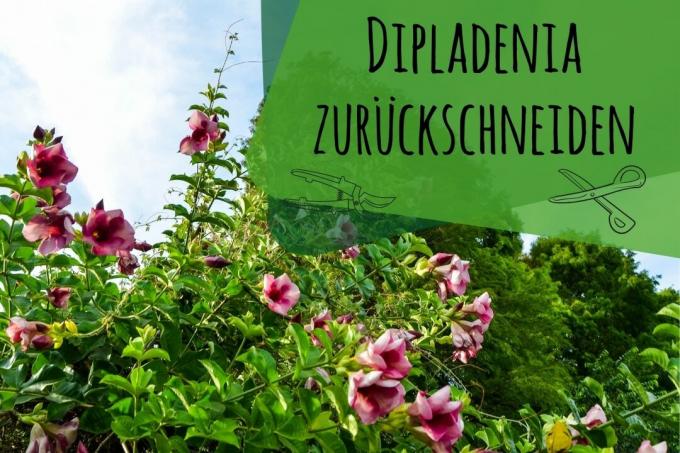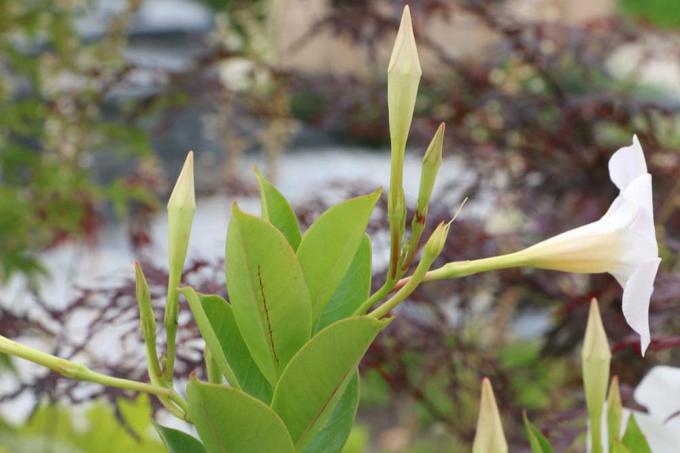
table of contents
- Why do you need to prune?
- Instructions for cutting back
- Different types of cuts
- Maintenance and conservation cut
- Topiary
- Taper cut
- Cut back for winter quarters
- Cut sick shoots
- Pinching
- The right tool
- frequently asked Questions
The climbing beauty from the tropical areas of South America enchants with its funnel-shaped flowers during the summer months. Dipladenia can be overwintered well. However, after the hibernation, the Dipladenia must be cut back.
In a nutshell
- Dipladenia is not hardy, overwinter indoors at 5 to 10 ° C
- Dipladenia are very easy to cut
- different types of cuts possible
- The best time to cut back the overwintered plants is in February / March
- only use a sharp tool for cutting back
Why do you need to prune?
Typically, the commercially available plants are treated with an anti-stiffening agent, also known as a growth inhibitor, to keep them small and stocky. However, this remedy diminishes after a successful hibernation. Then a Dipladenia, which is also known as a Mandevilla, can quickly reach a height of 300 centimeters. Usually a cut back is then made to regulate the size. There are also other reasons to prune the plant:
- to prevent the plants from becoming bald
- to achieve a bushy growth
- to stimulate increased flower formation
- to prepare for winter
- in the event of disease and pest infestation
Note: A Mandevilla can easily be overwintered in the house at temperatures between 5 and 10 ° C.
Instructions for cutting back
As a rule, dipladenia are very easy to care for and tolerate pruning well. In general, however, a few things must be taken into account when pruning:

- Prune the plant outdoors
- Milky sap contaminates carpets, wood and natural stones
- Place the pot on foil / newspaper
- no pruning in rain or dry weather
- otherwise poor wound healing and
- easy penetration of germs possible
- Do not squeeze shoots
- make smooth cuts
- Do not tear open the interface
- Always place the scissors 1 to 2 mm above the outward-facing eye
- use sharp tools
- wear gloves when cutting
- leaking, toxic milky sap can cause skin irritation
- Wash hands thoroughly after cutting
Note: The Dipladenia belongs to the dog poison family. All parts of the plant are poisonous and contain a white milky sap.
Different types of cuts
To get a Dipladenia back into shape and at the same time lay the foundation for a healthy one There are several options for one to create development, growth and abundant flowering Cut back:
Maintenance and conservation cut
This takes place once a year after the winter rest. The optimal time is early spring, in February / March before the plants sprout again. This cut keeps the Dipladenia nice and compact and also stimulates the formation of new shoots and flower buds. Dipladenia always form flower buds on this year's shoots. Therefore:
- all dead shoots at the base completely removed
- all previous year's and withered shoots cut back
- Side and main shoots shortened by half
- Shoots shortened to two pairs of buds or leaves

However, if the plant is to keep its original size, the side shoots are simply shortened and the main shoots keep their size.
Topiary
This pruning can be done all year round, including during the flowering period. Tendrils that are too long can be cut here. However, it must be ensured that the flowers appear on this year's shoots. Perhaps shoots that are too long should then be attached to the climbing aid. In addition, the cleaning of the withered flowers is part of the topiary, even if the creeper itself is cleaning. However, the withered flowers take a little longer to shed and seeds can then quickly form.
Taper cut
If the plant has grown too big or has become bald over time, a rejuvenating cut can rebuild it. However, such a radical cut will flower later in the year. On the other hand, this is all the more lush in the following season. Please note:
- Radical pruning before new growth in spring
- Shorten all shoots by half or to a third
- two leaf resp. Let the flower buds stand
- Perform rejuvenation pruning every few years
Note: The larger the cut, the more milky sap flows. To stop the wound flow, spray cuts with water. Alternatively, cover the wound with a cotton ball or small balls of paper tissues.

Cut back for winter quarters
Before the Dipladenia into winter quarters moves, you should cut them back again in autumn. If possible, it should not be too lush, you just have to orientate yourself on the available space. Please note:
- If the location is dark, shorten shoots only a few centimeters
- lighter square cut back by half or a third
The plants usually recover very quickly and sprout again. However, you then need:
- a bright location
- no cool temperatures
- regular watering
- no waterlogging
- fertilize in spring after pruning
Note: Cut off shoots, especially head shoots with at least three pairs of leaves and a length of 10 to 15 cm, can be used to propagate cuttings.
Cut sick shoots
If dipladenia suffer from diseases and pests, it is necessary to remove all affected shoots at the base. Such a pruning can take place at any time. Sometimes a radical cut is necessary.
Pinching
Pinching, also known as pruning, leads to a bushier growth of young plants. It should be done several times during budding. Instructions for this as follows:
- Put on disposable gloves
- therefore better sensitivity
- Remove shoot tips from all shoots
- break them off laterally below the first pair of leaves
- thereby increased formation of side shoots and flower buds
The right tool
The shoots hardly lignify in these plants. They are quite thin and pliable. One-handed scissors with a so-called bypass mechanism are ideal for cutting back Dipladenia. These have the following advantages:

- two sharp edges available
- these are running past each other when the handle is pressed together
- this causes small cuts
- smooth cut surfaces
In addition, the cutting edges should be clean and disinfected. It is also necessary to wear gloves.
frequently asked Questions
Especially in the summer of the main vegetation period, the parts of the plant increasingly carry the toxic milky sap. In the event of a cut back, more milky sap would therefore escape from the cut wound. Because of the heat, the wounds would take much longer to heal from the hardening of the juice. However, sick or obstructing shoots or shoots for cuttings should still be cut.
It is not absolutely necessary. Only if the pot has already become too small. Root shoots that are too long can then be cut back. Usually repotting is required every three years.
The shoots are squeezed due to blunt scissors, the interfaces are frayed and pathogens can enter quickly. Furthermore, a pruning too late will result in late flowering. If the Dipladenia is only slightly cut back, the plant will become bald over time. The weather is also decisive when pruning, in rainy weather the risk of infection with fungi is very high, in the sun the cuts burn.



